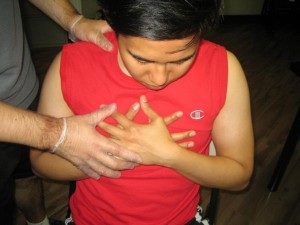Stable angina is the most common type of angina. It is characterized by chest pain or discomfort that manifests with stress or activity. Stable angina has a regular pattern with regard to regularity, intensity and risk factors, where pain lasts for a few minutes or until medication is taken. In contrast, unstable angina is when there is not regular pattern and may become more frequent and intense than stable angina.The medical term for stable angina is angina pectoris.
The heart needs a constant supple of oxygen as it is working all the time, thus when it does not get its sufficient amounts of blood, angina occurs. Angina is chest pain or discomfort that results from insufficient amount of oxygen-rich blood received by the heart.Angina is not a diagnosis on its own, but rather, it is commonly a symptom of an underlying heart condition, such as coronary heart disease, the most common type of heart disease in adults. Moreover,stable angina is suggestive of myocardial infarction (heart attack) in the future.
Causes of Stable Angina
Millions of people suffer from stable angina each year. Stable angina is commonly associated with coronary heart disease, but there are other conditions that may also cause chest discomfort. However, it is important to note that not all chest pain or discomfort is angina. The following medical conditions may also lead to stable angina:
- Atherosclerosis
- Blood clot, pulmonary embolism
- Lung infection
- Aortic dissection
- Aortic stenosis
Risk Factors for Stable Angina
Having certain diseases can predispose an individual to stable angina, however, the environment and particular lifestyle factors may also increase an individual’s chance of developing angina. The following include:
- Medical or health conditions:
- Hypertension
- Diabetes
- High LDL cholesterol and low HDL cholesterol
- Anaemia
- Abnormal heart rhythms
- Coronary heart spasm
- Heart failure
- Heart valve disease
- Hyperthyroidism
- Environmental or lifestyle factors coupled with a heart disease:
- Smoking
- Cold weather
- Eating large meals
- Exercise
- Emotional stress
Symptoms of Stable Angina
Symptoms of stable angina can be anticipated as they seem to have a regular pattern, such as after doing an activity or exercising. The symptoms of stable angina will typically improve after resting or slowing down, which commonly include:
- Chest pain or discomfort that occurs behind the sternum (breastbone) or marginally to its left that increases in intensity within the next minutes before gradually disappearing (usually lasts from 1 – 15 minutes)
- Pain may be sharp or dull, or like a tightness, heavy pressure present in the chest
- May radiate to the, jaw, neck, shoulder, arm (typically to the left) or back
- Dyspnea
- Weakness and fatigue
- A feeling of indigestion
- Nausea and vomiting
- Dizziness or light-headedness
- Sweating
- Heart palpitations
First Aid Management for Stable Angina
Treatment will usually involve medications, lifestyle changes and surgical

procedures. However, if one experiences angina for the first time, call for emergency medical services, as angina may be a symptom of a heart attack. The following is generally recommended:
- Assist the person into a comfortable position. Keep the person calm and reassure him/ her that help is on the way. Do not leave the person alone.
- If the person has medication for angina with them, assist them in taking the medication.
- Check and monitor the person’s vital signs. If necessary, commence CPR.
Assisting a person experiencing stable angina is necessary. Understanding stable angina can be a very helpful when taking First Aid Training and CPR Courses, as it is a common symptom for many medical emergencies.
Source:
Stable angina.(2012). National Institutes of Health. Retrieved on October 6, 2013, from http://www.nlm.nih.gov/medlineplus/ency/article/000198.htm